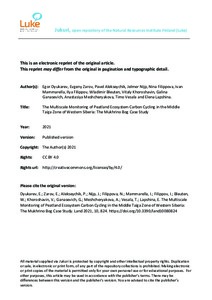The Multiscale Monitoring of Peatland Ecosystem Carbon Cycling in the Middle Taiga Zone of Western Siberia: The Mukhrino Bog Case Study
Dyukarev, Egor; Zarov, Evgeny; Alekseychik, Pavel; Nijp, Jelmer; Filippova, Nina; Mammarella, Ivan; Filippov, Ilya; Bleuten, Wladimir; Khoroshavin, Vitaly; Ganasevich, Galina; Meshcheryakova, Anastasiya; Vesala, Timo; Lapshina, Elena (2021)
Dyukarev, Egor
Zarov, Evgeny
Alekseychik, Pavel
Nijp, Jelmer
Filippova, Nina
Mammarella, Ivan
Filippov, Ilya
Bleuten, Wladimir
Khoroshavin, Vitaly
Ganasevich, Galina
Meshcheryakova, Anastasiya
Vesala, Timo
Lapshina, Elena
Julkaisusarja
Land
Volyymi
10
Numero
8
Sivut
26 p.
MDPI AG
2021
Julkaisun pysyvä osoite on
http://urn.fi/URN:NBN:fi-fe2021112356432
http://urn.fi/URN:NBN:fi-fe2021112356432
Tiivistelmä
The peatlands of the West Siberian Lowlands, comprising the largest pristine peatland area of the world, have not previously been covered by continuous measurement and monitoring programs. The response of peatlands to climate change occurs over several decades. This paper summarizes the results of peatland carbon balance studies collected over ten years at the Mukhrino field station (Mukhrino FS, MFS) operating in the Middle Taiga Zone of Western Siberia. A multiscale approach was applied for the investigations of peatland carbon cycling. Carbon dioxide fluxes at the local scale studied using the chamber method showed net accumulation with rates from 110, to 57.8 gC m−2 at the Sphagnum hollow site. Net CO2 fluxes at the pine-dwarf shrubs-Sphagnum ridge varied from negative (−32.1 gC m−2 in 2019) to positive (13.4 gC m−2 in 2017). The cumulative May-August net ecosystem exchange (NEE) from eddy-covariance (EC) measurements at the ecosystem scale was −202 gC m−2 in 2015, due to the impact of photosynthesis of pine trees which was not registered by the chamber method. The net annual accumulation of carbon in the live part of mosses was estimated at 24–190 gC m−2 depending on the Sphagnum moss species. Long-term carbon accumulation rates obtained by radiocarbon analysis ranged from 28.5 to 57.2 gC m−2 yr−1, with local extremes of up to 176.2 gC m−2 yr−1. The obtained estimates of various carbon fluxes using EC and chamber methods, the accounting for Sphagnum growth and decomposition, and long-term peat accumulation provided information about the functioning of the peatland ecosystems at different spatial and temporal scales. Multiscale carbon flux monitoring reveals useful new information for forecasting the response of northern peatland carbon cycles to climatic changes.
Collections
- Julkaisut [87121]
